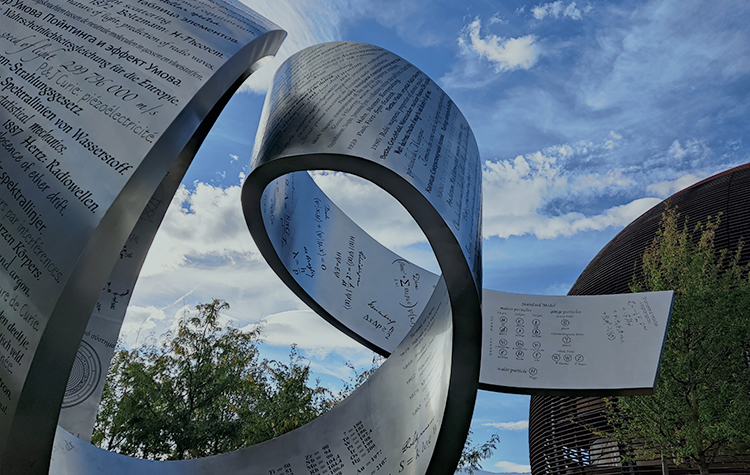
We’re excited to share our learnings from the recent Science, Science Fiction and Storytelling workshop at IdeaSquare, the innovation space at CERN — when meanings and perceptions are fluid and changing, mixing disciplines is the solution to inspire new approaches.
At wonnd, we believe that frames are not rigid and we are permanently searching for new ways to approach challenges, especially for an uncertain future. We encourage the mixing of disciplines, people, ideas: this is the perfect way to create. And we are always willing to collaborate in multidisciplinary discussions where we can learn from others, and co-create new frameworks with colleagues from other knowledge areas then apply them to help our clients solve their challenges.
That’s why I’m so thrilled that a few days ago I was part of the Science, Science Fiction and Storytelling workshop at IdeaSquare, the innovation space at CERN, in Geneva, Switzerland. The workshop was organized by Markus Nordberg, physicist and Head of IdeaSquare, and Una McCormack, science fiction writer and New York Times and USA Today bestselling author of over two dozen novels.
For 2 days I was privileged to be part of a mixed cohort of specially invited science fiction writers, philosophers, futurists, designers, anthropologists, political scientists, sociologists, psychologists, historians, engineers, and physicists. Together we explored the relationship between science, technology and society: How can science fiction articulate speculations about the future? What can we learn from science fiction about the role of science and technology in the future?
During the planning stages, and while searching for cross-disciplinary experiences for the workshop, I had the privilege to work closely with Una in exploring the intersection of how designers and writers work to envision future scenarios. It was a very interesting and playful experience. In addition to having a lot of fun with Una, we exchanged many methods, work frames and approaches to scenario creation. We were looking for a selection of methodologies and approaches that could give participants a wide range of strategies for speculative scenario creation.
As a result of this collaboration, I designed and facilitated one of the activities during the workshop. Participants worked in teams to create an imaginary post-truth scenario, and prototyped a human-machine interaction through a mini theater play. It was a fascinating and lively experience, that helped participants explore possible interactions with technology created in a future context. 1
A toolkit for creative minds willing to extrapolate the future
One of the purposes of the workshop was to work towards building and trialing a shared multidisciplinary ‘toolkit’ for creative exercises in various formats, which can be used by scientists and storytellers, designers and innovators to generate speculative scenarios. We researched different methods, that led us to diverse outputs:
- We explored The thing of the future2 by The Situation Lab, an award-winning imagination game that challenges players to collaboratively and competitively describe objects from a range of alternative futures.
- We co-created stories about the future by exploring Imagining the future: What could possibly go wrong?, a step-by-step guide by Adam Marek to envisioning how future technological developments can be extrapolated from scientific reporting and developed into compelling story ideas. 3
- We got familiar with the concept of Megatext 4 in science fiction, as a shared space of concepts and terminology (fictional background, tropes, images, and conventions) that many science fiction writers use when they create their stories.
- As a multidisciplinary group, we explored designing and testing our own new tools using different approaches: exercises to map the terrain of a futuristic environment, exercises to create a technological advance and explore its impact, and exercises to explore pathways to a future beyond conflict. It was a great experience both creating them, and experimenting with the creations of others.
- And the mini theater play, as a prototyping and story-telling tool!
One great overall insight from this enriching experience was that, when speculating about the future and exploring creativity, strategic designers and writers approach the creative method in a very similar way. Divergence processes provoked by diverse stimulus and prototyping; and convergence by tools that help structure the story. This alignment was both a surprise and reassuring!
Do you want to know more about introducing these tools for facing your challenges with an uncertain future? Contact us! At wonnd we believe that the approach is part of the solution.
- This exercise was partly inspired by the Stanford d.school book Creative Acts for curious people by Sarah Stein Greenberg, particularly the Build a Bot exercise featuring the work of Ariam Mogos, Laura McBain, Megan Stariha, Carissa Carter, and Karen Ingram.
Also by the mini theater prototyping done with Alessia Rullo during the last academic year for the students from the Master’s Degree in Service Design at BAU, College of Arts and Design in Barcelona. ↩︎ - https://situationlab.org/project/the-thing-from-the-future/ ↩︎
- In the book Writing the future: Essays on crafting science fiction (2023). Edited by Dan Coxon and Richard V. Hirst ↩︎
- https://sf-encyclopedia.com/entry/sf_megatext ↩︎